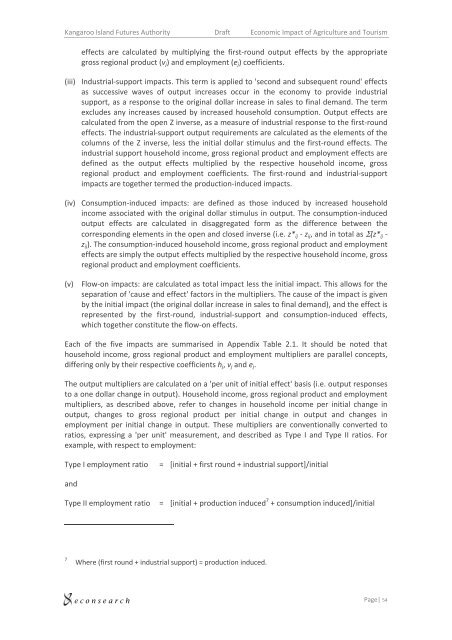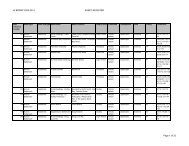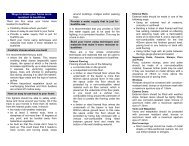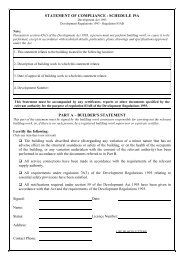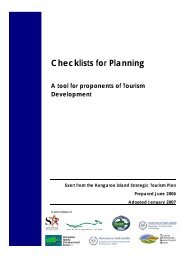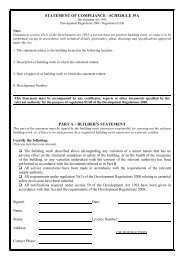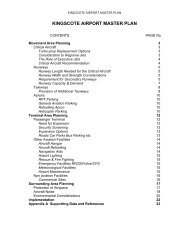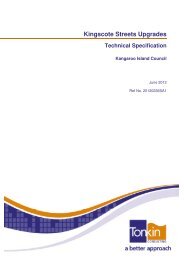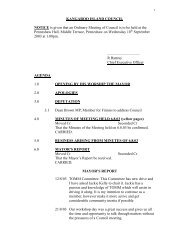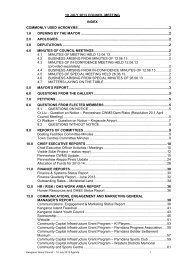Kingscote Airport Business Case Appendices - Kangaroo Island ...
Kingscote Airport Business Case Appendices - Kangaroo Island ...
Kingscote Airport Business Case Appendices - Kangaroo Island ...
- No tags were found...
You also want an ePaper? Increase the reach of your titles
YUMPU automatically turns print PDFs into web optimized ePapers that Google loves.
<strong>Kangaroo</strong> <strong>Island</strong> Futures Authority Draft Economic Impact of Agriculture and Tourismeffects are calculated by multiplying the first-round output effects by the appropriategross regional product (v j ) and employment (e j ) coefficients.(iii) Industrial-support impacts. This term is applied to 'second and subsequent round' effectsas successive waves of output increases occur in the economy to provide industrialsupport, as a response to the original dollar increase in sales to final demand. The termexcludes any increases caused by increased household consumption. Output effects arecalculated from the open Z inverse, as a measure of industrial response to the first-roundeffects. The industrial-support output requirements are calculated as the elements of thecolumns of the Z inverse, less the initial dollar stimulus and the first-round effects. Theindustrial support household income, gross regional product and employment effects aredefined as the output effects multiplied by the respective household income, grossregional product and employment coefficients. The first-round and industrial-supportimpacts are together termed the production-induced impacts.(iv) Consumption-induced impacts: are defined as those induced by increased householdincome associated with the original dollar stimulus in output. The consumption-inducedoutput effects are calculated in disaggregated form as the difference between thecorresponding elements in the open and closed inverse (i.e. z* ij - z ij , and in total as Σ(z* ij -z ij ). The consumption-induced household income, gross regional product and employmenteffects are simply the output effects multiplied by the respective household income, grossregional product and employment coefficients.(v) Flow-on impacts: are calculated as total impact less the initial impact. This allows for theseparation of 'cause and effect' factors in the multipliers. The cause of the impact is givenby the initial impact (the original dollar increase in sales to final demand), and the effect isrepresented by the first-round, industrial-support and consumption-induced effects,which together constitute the flow-on effects.Each of the five impacts are summarised in Appendix Table 2.1. It should be noted thathousehold income, gross regional product and employment multipliers are parallel concepts,differing only by their respective coefficients h j , v j and e j .The output multipliers are calculated on a 'per unit of initial effect' basis (i.e. output responsesto a one dollar change in output). Household income, gross regional product and employmentmultipliers, as described above, refer to changes in household income per initial change inoutput, changes to gross regional product per initial change in output and changes inemployment per initial change in output. These multipliers are conventionally converted toratios, expressing a 'per unit' measurement, and described as Type I and Type II ratios. Forexample, with respect to employment:Type I employment ratio= [initial + first round + industrial support]/initialandType II employment ratio= [initial + production induced 7 + consumption induced]/initial7Where (first round + industrial support) = production induced.e c o n s e a r c hPage| 54


